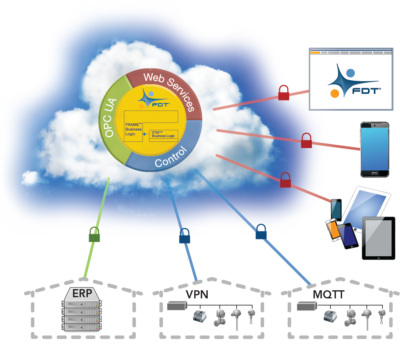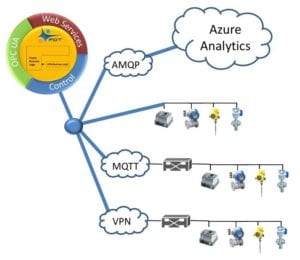
The Industrial Internet of Things (IIoT) and Industrie 4.0 are here and they’re changing the way manufacturers think about business. The desire for increased connectivity and access to valuable “smart data” available from intelligent assets is the key factor to empower modern plants and factories with control strategies for the new era of automation.
To truly enable IIoT, industrial manufacturers need an innovative architecture allowing control from end-to-end for real-time analytics – enabling smarter business and operational practices. A big part of this approach involves collecting data near the source, at the edge of the network. It also means polling as close to the devices as possible.
The following article describes how FDT Group’s new IIoT server solution promises to optimize device and network connectivity, and expand information sharing, for today’s intelligent enterprise. To advance its support for the next generation of automation, and meet the demands of the end user community, FDT Group has developed the FDT IIoT Server (FITS™). This technology will help make IIoT a reality via a broad ecosystem that spans the process, hybrid and factory automation markets, and involves controls and instrumentation suppliers, end users, standards organizations, etc. – all aimed at promoting interoperability, security and mobility through new, adaptive manufacturing assets.
FITS is intended to protect legacy investments in the FDT standard through advanced business logic, well-defined interfaces and common components, while also providing the foundation for a modern, integrated automation architecture.
The FITS solution greatly simplifies the move to IIoT. With core FDT components (i.e., FDT/FRAME™ and FDT/DTM™ business logic) at the heart of the architecture, three interfaces empower a flexible implementation strategy: OPC Unified Architecture (OPC UA) integration, Web Services and rich control network interoperability to optimize connectivity and information exchange. The architecture can scale to suit the needs of a single manufacturing facility or an entire industrial enterprise. In addition, the FITS solution features robust layered security addressing all components of the server architecture. It leverages vetted industry standards and encrypted communications, with Transport Layer Security (TLS) utilizing Hyper Text Transfer Protocol Secure (HTTPS) and Web Socket Secure (WSS) communication protocols. FDT Group developed FITS to support increased enterprise information exchange in the industrial sector. The organization implemented OPC UA natively on its IIoT server to enable sensor-to-cloud, enterprise-wide connectivity – making it possible to share information between higher-level applications and the server architecture.
Together, FDT and OPC UA employ a publish-subscribe methodology allowing sensor, network and topology information to permeate the enterprise, including mobile devices, Distributed Control Systems (DCSs), Programmable Logic Controllers (PLCs), Manufacturing Execution Systems (MESs), Enterprise Resource Planning (ERP) systems, the cloud, IIoT and Industry 4.0. FDT’s approach further provides access to real-time plant information and asset health data with NAMUR NE107 diagnostics available throughout the plant topology via its network tunneling capability.
A key enhancement to the FITS architecture, Web Services, provides a standardized mobile access approach utilizing browsers, apps, standalone applications, or anything else capable of interfacing via web sockets. Users can take advantage of standard browsers to gain access to Device Type Managers™ (DTMs) and FDT/FRAME-enabled systems, or write custom apps and programs. With FITS, enterprise connectivity remains intact no matter how the server is deployed, whether it is directly connected to the IIoT, interfaced in the fog, located in the cloud, or established as a standalone application. Connectivity with industrial control systems can be achieved via several optional approaches:

The FDT IIoT Server provides options for industrial control system connectivity.
- Traditional direct connections
- Secure remote connections
- Cloud connections
- Edge devices via the Message Queuing Telemetry Transport (MQTT) protocol
- Virtual Private Network (VPN) to firewall
- Azure AMQP
- Any other cloud method (i.e., a different FDT COMM DTM)
- Single server for multiple plants/locations
- Enterprise-wide from a single cloud instance
The versatility of the FITS solution enables plants and factories to: 1.) Extend connectivity beyond enterprise boundaries to smart devices, 2.) Offer connectivity capabilities optimized for sensors and devices, 3.) Deliver relevant data to intelligent decision-making assets to derive business value, and 4.) Enable increased scalability of deployment and management of solutions.
For example, a fog computing strategy provides decentralized computing by bringing the intelligence of the cloud closer to end devices, such as pumps, motors, sensors, relays, etc. Intelligence is pushed down to the Local Area Network (LAN) level of the network architecture, and data from the control system program is sent to an OPC server or protocol gateway, which converts the data into a protocol Internet systems understand. MQTT is one of many internet-enabled publisher/subscriber messaging transport applications available for edge devices, offering increased communication and data collection. Remote access applications enable remote users to monitor and control machines through secure VPN connections. Database integration allows smart devices to log data directly to database servers over a LAN. Custom server/client applications integrate smart devices on tablets for monitoring and control, moving the touch screen out of the panel and into the operator’s hands.
The Azure Advanced Message Queuing Protocol (AMQP) is a wire-level messaging protocol that can be used for cross-platform messaging applications. The protocol defines the mechanics of message transfer between two parties. Azure Stream Analytics is a real-time event-processing engine that helps to unlock insights from data and makes it easy to set up real-time analytic computations on data streaming from devices, sensors, applications, systems, etc. A FITS instance can push data to cloud applications such as Azure by using either OPC UA or an AMQP Gateway DTM. A key feature of FDT for operational management and maintenance applications, among others – and an indication of its pivotal position in an intelligent, connected enterprise – is the ability to seamlessly tunnel through a myriad of networks to transparently communicate with end devices. Communication tunneling (i.e., the open integration of gateways and the integration of communication drivers via communication servers) occurs without the host needing to intervene in any way and without modifying the communications stack of any of the networks through which the tunneling occurs. With this approach, devices are arranged in a hierarchy and interconnect through different protocols. FDT enables seamless device data exchange, operation and maintenance via a computer to a higher-level network, as well as a reduction in the amount of software and hardware the end user needs to implement compared to other technologies.
In a typical industrial facility, communication tunneling might start from an Ethernet network hosting a control system, passing though several network layers to configure or communicate with a smart device. The FDT standard is written such that the end user has no awareness that routing through different networks is taking place. It’s as if they are directly connecting to the device and can access all of its intelligent features. This solution can accommodate traditional direct connection of the automation network, as well as secure remote connection of a cloud-based architecture encompassing edge devices.
FDT currently supports more than 16 automation industry networks, and its open architecture allows users to add networks to meet changing industry demands, including new IIoT/Industrie 4.0 networks. But the technology doesn’t simply allow them to coexist – it ensures seamless, end-to-end communications across disparate networks. The FDT standard provides true interoperability. FDT Group developed the FITS architecture to optimize the scale and functionality of the IIoT capabilities of its technology stack for enterprise-wide network and asset integration, as well as diverse control system connectivity. Indeed, FDT is the established, open standard, built to integrate and automate the ecosystem exchange by empowering the intelligent enterprise of industrial automation – standards, protocols, systems, devices, data exchanges, services, and more.